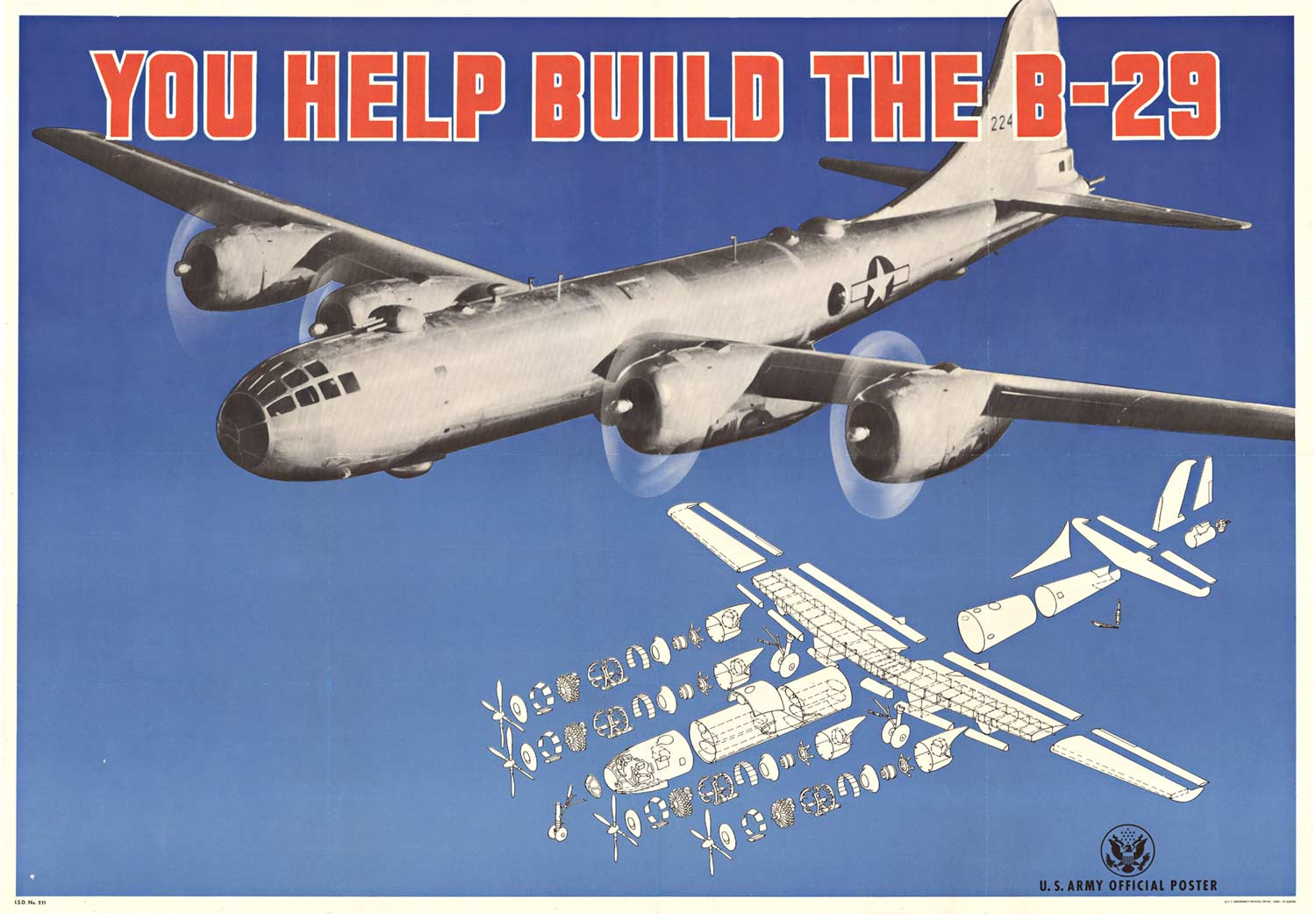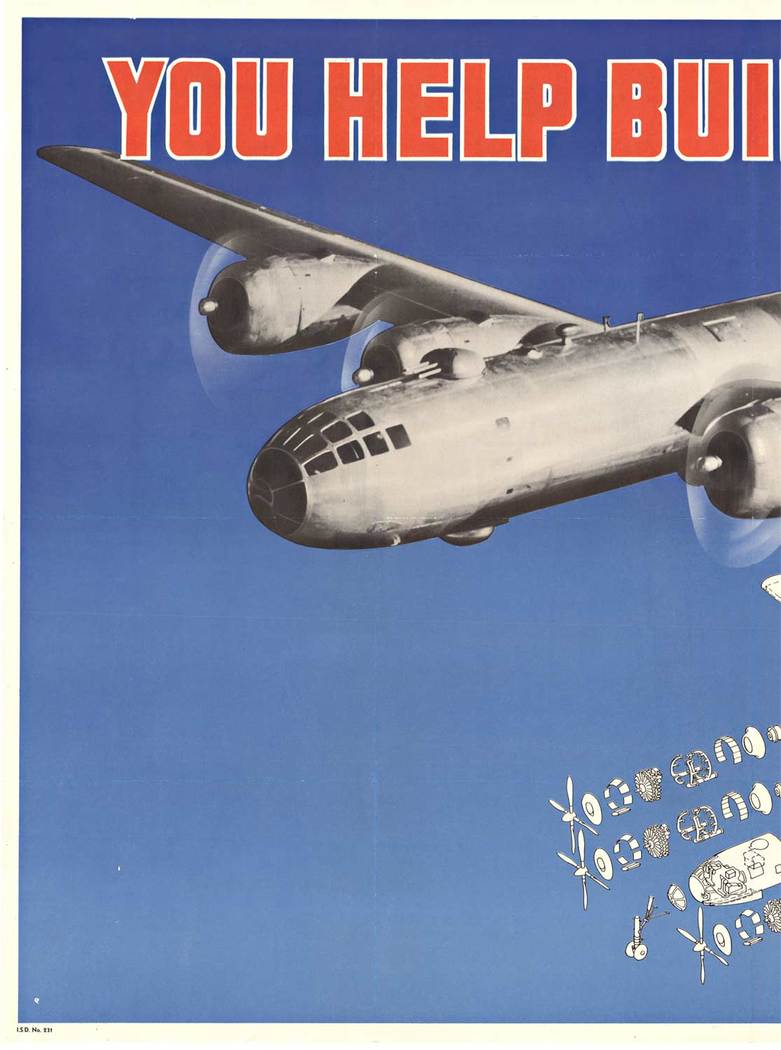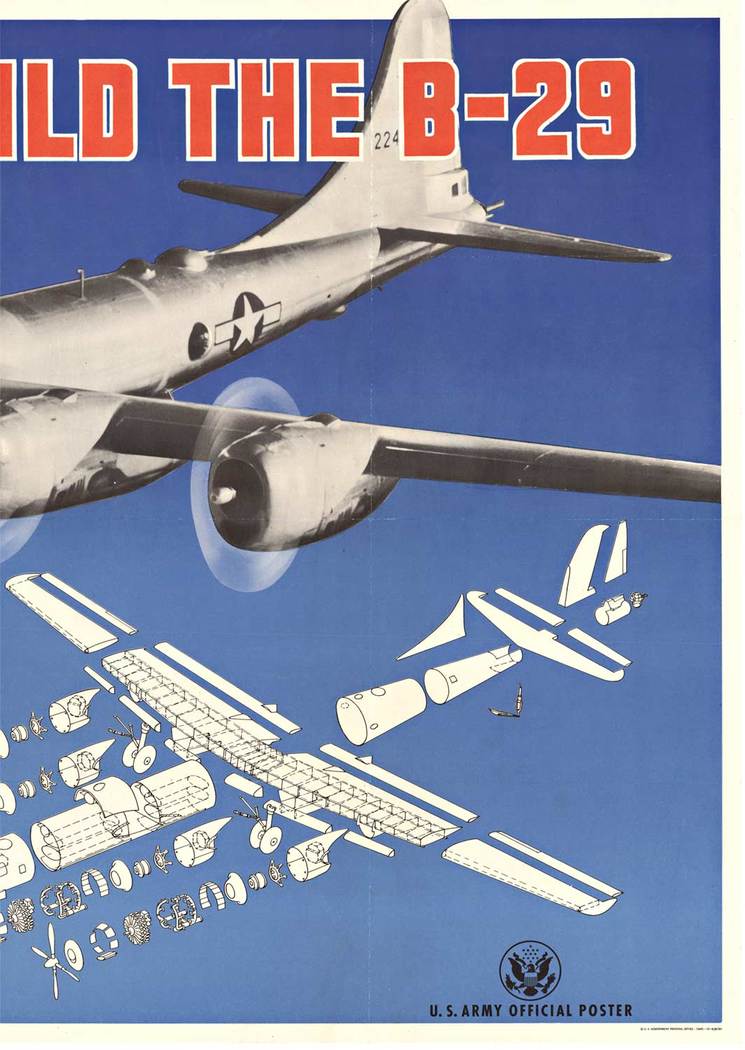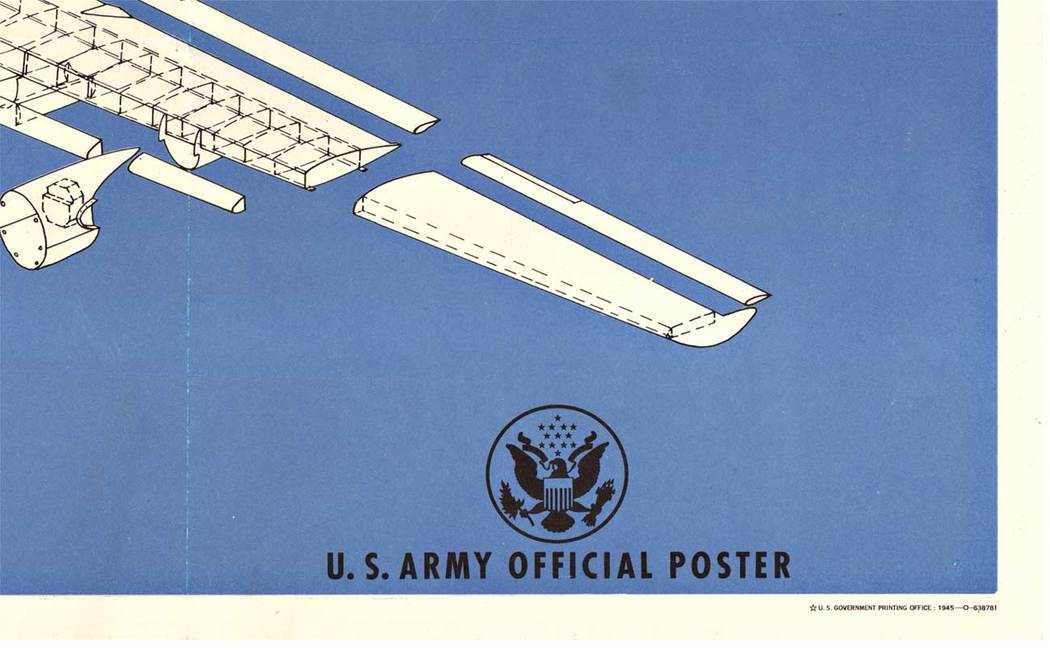Anonymous Artists
View Artist Biography




Title:
You Help Build the B-29
Date:
1945
Size:
37" x 26"
Medium:
Lithograph
Price:
$1,500.00
INV. #:
10457
Original. You Help Build the B-29 vintage poster. Linen-backed World War II poster. Restored original fold marks.
This original vintage US Army Official Poster was printed in 1945 and featured a detailed diagram of a B-29 bomber aircraft. The image showcases the impressive craftsmanship that went into the engineering of the B-29 bomber, and the professional design is sure to look amazing when framed and hung on your wall. Expertly linen-backed to ensure longevity, this charming poster is a perfect way to show your admiration for the ingenuity of the United States Army.
Flying across a bright blue sky is a silver B-29. Directly beneath it are the parts for the plane's construction, with the explanation that "You Help Build the B-29"!
"Boeing submitted the prototype for the B-29 long-range heavy bomber to the Army in 1939, before the United States entered World War II.
The Boeing B-29 Superfortress was the most advanced propeller-driven airplane in the world in 1945, making it the ultimate definition of a “modern” airplane. Designed to fly farther, faster, and higher than any other bomber, the combination of the B-29’s aerodynamic, structural, and propulsion innovations allowed it to carry 5,000 pounds of bombs to a target 1,500 miles away while cruising at 220 miles per hour at altitudes up to 30,000 feet. It also had advanced tricycle landing gear and was the first bomber to have an analog computer-controlled defensive armament system and a pressurized and heated fuselage that meant the 11-person crew did not have to wear oxygen masks and heavy, bulky clothing during long missions.
The B-29 had many new features, including guns that could be fired by remote control. The crew areas were pressurized and connected by a long tube over the bomb bays. The tail gunner had a separate pressurized area that could only be left during unpressurized flight. The B-29 was also the heaviest production plane because of its increased range, bomb load, and defensive requirements.
The B-29 used the high-speed Boeing 117 airfoil, and its larger Fowler flaps added to the wing area as they increased lift. Modifications led to the B-29D, upgraded to the B-50, and the RB-29 photo reconnaissance aircraft. The Soviet-built copy of the B-29 was called the Tupolev Tu-4.
The earliest B-29s were built before testing was finished, so the Army established modification centers where last-minute changes could be made without slowing expanding assembly lines
Boeing built a total of 2,766 B-29s at plants in Wichita, Kansas (previously the Stearman Aircraft Co., bought by Boeing in 1929) and in Renton, Wash. The Bell Aircraft Co. built 668 of the giant bombers in Georgia, and the Glenn L. Martin Co. built 536 in Nebraska. Production ended in 1946.
B-29s were primarily used in the Pacific theater during World War II. Finally, on Aug. 6, 1945, the B-29 Enola Gay dropped the world's first atomic bomb on Hiroshima, Japan. Three days later, a second B-29, Bockscar, dropped another atomic bomb on Nagasaki. Shortly thereafter, Japan surrendered.
After the war, B-29s were adapted for several functions, including in-flight refueling, anti-submarine patrol, weather reconnaissance, and rescue duty. The B-29 saw military service again in Korea between 1950 and 1953, battling new adversaries: jet fighters and electronic weapons. The last B-29 in squadron use retired from service in September 1960
#originalposter #vintageposter #B29
This original vintage US Army Official Poster was printed in 1945 and featured a detailed diagram of a B-29 bomber aircraft. The image showcases the impressive craftsmanship that went into the engineering of the B-29 bomber, and the professional design is sure to look amazing when framed and hung on your wall. Expertly linen-backed to ensure longevity, this charming poster is a perfect way to show your admiration for the ingenuity of the United States Army.
Flying across a bright blue sky is a silver B-29. Directly beneath it are the parts for the plane's construction, with the explanation that "You Help Build the B-29"!
"Boeing submitted the prototype for the B-29 long-range heavy bomber to the Army in 1939, before the United States entered World War II.
The Boeing B-29 Superfortress was the most advanced propeller-driven airplane in the world in 1945, making it the ultimate definition of a “modern” airplane. Designed to fly farther, faster, and higher than any other bomber, the combination of the B-29’s aerodynamic, structural, and propulsion innovations allowed it to carry 5,000 pounds of bombs to a target 1,500 miles away while cruising at 220 miles per hour at altitudes up to 30,000 feet. It also had advanced tricycle landing gear and was the first bomber to have an analog computer-controlled defensive armament system and a pressurized and heated fuselage that meant the 11-person crew did not have to wear oxygen masks and heavy, bulky clothing during long missions.
The B-29 had many new features, including guns that could be fired by remote control. The crew areas were pressurized and connected by a long tube over the bomb bays. The tail gunner had a separate pressurized area that could only be left during unpressurized flight. The B-29 was also the heaviest production plane because of its increased range, bomb load, and defensive requirements.
The B-29 used the high-speed Boeing 117 airfoil, and its larger Fowler flaps added to the wing area as they increased lift. Modifications led to the B-29D, upgraded to the B-50, and the RB-29 photo reconnaissance aircraft. The Soviet-built copy of the B-29 was called the Tupolev Tu-4.
The earliest B-29s were built before testing was finished, so the Army established modification centers where last-minute changes could be made without slowing expanding assembly lines
Boeing built a total of 2,766 B-29s at plants in Wichita, Kansas (previously the Stearman Aircraft Co., bought by Boeing in 1929) and in Renton, Wash. The Bell Aircraft Co. built 668 of the giant bombers in Georgia, and the Glenn L. Martin Co. built 536 in Nebraska. Production ended in 1946.
B-29s were primarily used in the Pacific theater during World War II. Finally, on Aug. 6, 1945, the B-29 Enola Gay dropped the world's first atomic bomb on Hiroshima, Japan. Three days later, a second B-29, Bockscar, dropped another atomic bomb on Nagasaki. Shortly thereafter, Japan surrendered.
After the war, B-29s were adapted for several functions, including in-flight refueling, anti-submarine patrol, weather reconnaissance, and rescue duty. The B-29 saw military service again in Korea between 1950 and 1953, battling new adversaries: jet fighters and electronic weapons. The last B-29 in squadron use retired from service in September 1960
#originalposter #vintageposter #B29
